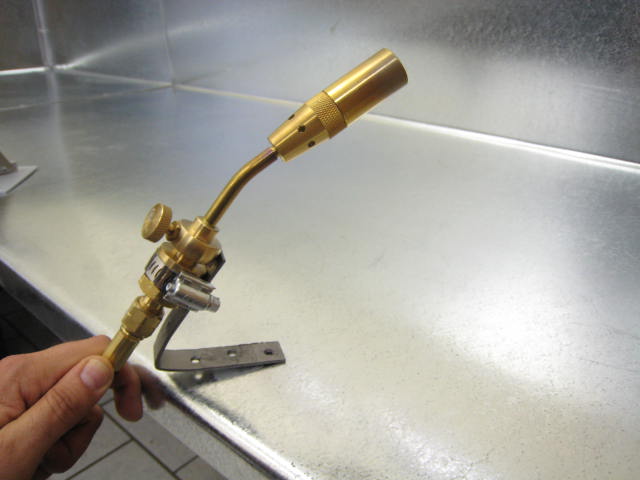Tips on Using the HOTHEAD
(Compiled by Glass&Fire, Villieria, Pretoria – Tel 0123299803)
Pros
- It is one of the cheapest torches on the market
- It is slow enough for a newby to learn how to control the glass and not have the glass control them.
- It has a wide bushy flame
- It can be used with 9kg LPG (Handigas) or propane cylinders
- Easy set-up
- The sodium flare is not so bad
- You do not need oxygen (cylinders or generators)
Cons
- It is noisy
- The Hot Head relies on ambient air to mix with the fuel for combustion, making it inefficient and - giving rise to a host of problems. These problems can be worked around by trial and error. You have to experiment to find the “Sweet spot”
- The flame is not as hot as an oxy/propane torch and big beads take substantially longer to make than on a torch with dual fuel.
- You can't adjust the flame chemistry, it's always got a reducing flame.
How to get the ‘Sweet spot”
There is a sweet spot in the flame where it is neutral (not propane rich). If you work farther out than the sweet spot, the flame will not be hot enough. If you work closer in than the sweet spot, you can reduce your glass and/or boil it. You must adjust the flame and where you work in it to find the sweet spot. You want a sharp blue cone in the flame. The sweet spot is usually about 2.5cm beyond the tip of that cone
Do’s and don’t’s
- Use a high pressure hose. Try and keep the gas cylinder outside
- Always open the valve on the tank all the way. A partially open valve can freeze up and cause problems with gas flow and make it difficult to close the valve
- Don't use a regulator. The hothead is made to be used at the full pressure of the tank
- After you light the torch, turn the valve up and down a little until you find the range where you are regulating the flame. Open the valve until the flame doesn't change anymore, then turn the flame down until you just see a slight change in the blue color of the inner cone of the flame. This is usually a good working flame. Work just above the tip of this cone. If you have trouble with soot, try working further out in the flame or turn the flame down a little more.
- If you have trouble with shooting orange flames you may have "gunk" from the tank in the hose. Disconnect the hose from the tank and torch and hang it up overnight to let the "gunk" drain out.
Maintainance
Bleed your hose:
Bleeding the hose is essential in keeping the orifice clean. It must be done after every session. Here’s how. Once you're done making beads:
Leave the torch burning.
Turn the tank off completely.
Let the torch burn the remaining fuel out of the hose. Eventually the flame will sputter out.
Leave the torch open until all the gas has escaped. The small amount of unburned fuel that will escape is harmless in a well-ventilated work area.
Don't forget to turn off the torch, otherwise you're in for a surprise next time you turn on the tank.
Why do this? If you leave the hose under pressure, the fuel vapour will condense in the hose and make a puddle that gets larger with each session. Two can things can happen:
The odor additives in the fuel can develop into "sludge" in your hose. This sludge migrates up into the torch because of the pressurized flow from the tank. This can foul the orifice and even the valve assembly if it’s allowed to go on too long.
If the “fuel puddle” in the hose gets big enough, the tank pressure will blow the liquid out through the torch. This creates a spectacular light show that looks like a flamethrower. It’s not especially dangerous, but it sure looks dangerous and is scary if you weren‘t expecting it.
Drain your hose:
When you take your tank to be refilled, drain your hose. Here’s how:
Disconnect the hose from your tank and hang it up.
Hang it with the open end (tank end) down.
To ensure flow, you can have your Hot Head Attached and open at the HIGH END.
Always keep the “torch end” high.
The condensed fuel will run out first followed by any oily sludge that has accumulated. It might be messy, so use a drip pan.
Tanks that stay in circulation for years sometimes become SLUDGY because the inside of the tank corrodes, etc. If you have this problem, take the tank back to the supplier and exchange it for a "clean" one. If it’s YOUR tank, have your gas supplier “PURGE IT”.
Once your torch gets dirty, you must be sure you are working with a clean hose and a clean tank before you hook up another torch (or your freshly cleaned torch). Drain or replace the hose and get the tank purged. We recommend replacing an older hose, but this isn’t always feasible so, drain it.
Bottom line: Always bleed the hose after every session and drain it every time you get fuel.
How to mount the Hot Head Torch

Use an ordinary “G-clamp to attach the bracket to your table.



